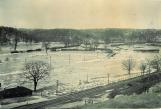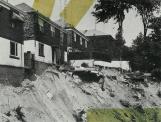1
The Don River had flooded with devastating results throughout the nineteenth and early twentieth centuries. In April 1850, flooding caused by rapid melting of snow along the headwaters of the Don carried away two bridges spanning the river. A flood in September 1878 destroyed many of the old mills on the Don.3
By the 1900s, logging and urban development had cleared much of the Don watershed of its forests. The eroded and denuded hills were unable to absorb heavy rains or rapid snow melt, and flooding became a regular occurrence in the Valley.5
But none of these floods rivalled the devastation brought by Hurricane Hazel, which struck southwestern Ontario on October 15, 1954.Overnight the Don River rose more than 15 feet above its normal October levels. Local residents described the muffled sounds of explosions at the nearby Brick Works as the water reached the fires in the brick kilns and extinguished them.
Fortunately, there was no loss of life in the Don Valley. But millions of dollars of property damage were sustained.
Every bridge on the Don was damaged. Smaller
bridges north of Danforth Avenue were forced off their pilings and were later found jammed against the Viaduct. In the Rosedale Ravine, the apiary of John McArthur, consisting of 40 beehives, was found floating more than half a mile from its location. All the bees had drowned.
6
However, the tragedy brought unexpected benefits for the community and the city. The storm's impact confirmed the need for conservation of lands lying in the floodplains. Fred G. Gardiner, Chairman of the Toronto Council, was one of the first public officials to acknowledge that lands lying next to rivers should be zoned as green belts, managed by local municipalities.In December 1954, a $1.6 million plan to re-locate more than 280 homes from low-lying lands in suburban municipalities was approved. These lands became green belts.

